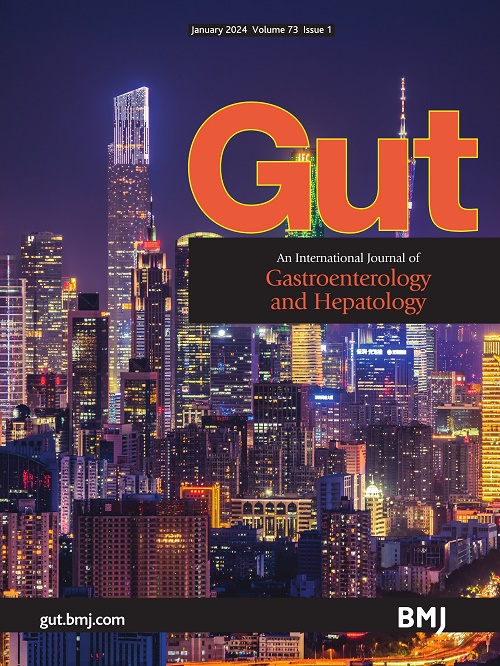在胆汁酸腹泻患者中,胰岛素样肽5响应胆汁酸在直肠中释放并与腹泻严重程度相关。
IF 25.8
1区 医学
Q1 GASTROENTEROLOGY & HEPATOLOGY
引用次数: 0
摘要
背景:胰岛素样肽5 (INSL5)是一种在结肠远端L细胞中表达的肠内分泌激素。已知胆汁酸受体激动剂可以刺激原代细胞培养中INSL5的分泌,并且在动物中使用INSL5类似物可以促进结肠运动。目的:本研究使用一种新的免疫测定法来测量人血液样本中的INSL5,从而评估直肠胆汁酸是否会刺激人体内INSL5的释放,以及慢性腹泻患者体内INSL5的水平是否会改变。设计:使用先前进行的研究的血清/血浆样本,包括接受牛磺酸(TCA)直肠灌肠的健康志愿者(n=7);健康志愿者的空腹和餐后样本(n=10);胆汁酸腹泻(BAD)患者(n=19)或肠易激综合征伴腹泻(IBS-D)患者(n=8);IBS-D患者(n=64)接受昂丹司琼或安慰剂治疗。结果直肠TCA组而非对照灌肠组可迅速提高血浆INSL5,且INSL5的升高与灌肠后排便时间呈负相关,与排便意愿呈正相关。健康志愿者中有42%的人INSL5水平较低(100 pg/mL),该亚组在接受昂丹司琼治疗后大便一致性有较大改善(p<0.05)。结论直肠胆汁酸可刺激人体内INSL5的分泌,且INSL5水平与结肠促运动反应和慢性腹泻的病理生理有关。本文章由计算机程序翻译,如有差异,请以英文原文为准。
Insulin-like peptide 5 is released in response to bile acid in the rectum and is associated with diarrhoea severity in patients with bile acid diarrhoea.
BACKGROUND
Insulin-like peptide 5 (INSL5) is an enteroendocrine hormone expressed in distal colonic 'L cells'. Bile acid receptor agonists are known to stimulate INSL5 secretion in primary cell culture, and administration of an INSL5 analogue in animals promotes colonic motility.
OBJECTIVE
This study used a new immunoassay to measure INSL5 in human blood samples, enabling assessment of whether rectal bile acids stimulate INSL5 release in humans and whether INSL5 levels are altered in patients with chronic diarrhoea.
DESIGN
Serum/plasma samples from previously performed studies were used, including healthy volunteers (n=7) who received a rectal enema of taurocholic acid (TCA); fasting and post prandial samples from healthy volunteers (n=10); patients with bile acid diarrhoea (BAD) (n=19) or irritable bowel syndrome with diarrhoea (IBS-D) (n=8); and patients with IBS-D (n=64) treated with ondansetron or placebo.
RESULTS
Rectal TCA but not a control enema promptly elevated plasma INSL5, with the increase in INSL5 correlating negatively with time to, and positively with desire to, defecate post enema. Healthy volunteers had low INSL5 levels (<100 pg/mL), with no change following a mixed meal. Patients with BAD had elevated INSL5 levels, with average stool consistency being positively correlated with serum INSL5 (p<0.001). In people with IBS-D, INSL5 was elevated (>100 pg/mL) in 42%, and this subgroup showed greater improvements in stool consistency with ondansetron therapy (p<0.05).
CONCLUSION
The study highlights that rectal bile acids stimulate INSL5 secretion in humans, and that INSL5 levels are associated with a colonic pro-motility response and pathophysiology of chronic diarrhoea.
求助全文
通过发布文献求助,成功后即可免费获取论文全文。
去求助
来源期刊

Gut
医学-胃肠肝病学
CiteScore
45.70
自引率
2.40%
发文量
284
审稿时长
1.5 months
期刊介绍:
Gut is a renowned international journal specializing in gastroenterology and hepatology, known for its high-quality clinical research covering the alimentary tract, liver, biliary tree, and pancreas. It offers authoritative and current coverage across all aspects of gastroenterology and hepatology, featuring articles on emerging disease mechanisms and innovative diagnostic and therapeutic approaches authored by leading experts.
As the flagship journal of BMJ's gastroenterology portfolio, Gut is accompanied by two companion journals: Frontline Gastroenterology, focusing on education and practice-oriented papers, and BMJ Open Gastroenterology for open access original research.
 求助内容:
求助内容: 应助结果提醒方式:
应助结果提醒方式:


